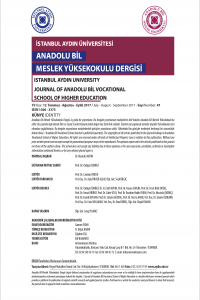Aile işletmesi kavramının literatürdeki tanımlamaları ve bu tanımlamalar hakkında çeşitli yorumlar
Bu makalede “aile işletmesi” kavramının tanımlamaları ele alınmıştır. Aile işletmeleri hakkındaki çalışmalar incelendiğinde “aile işletmesi olmanın” farklı çalışmalarda farklı anlayışlarla değerlendirildiği ortaya çıkmaktadır. Bu makale ile söz konusu çalışmalardaki farklı aile işletmesi tanımlamaları gruplanmış ve tanımlamaların her bir grubuna yönelik olarak çeşitli yorumlar yapılmıştır
Anahtar Kelimeler:
Aile işletmesi, sahiplik, yönetim
The definitions of family business concept in literature and some comments on these definitions
In this paper, the definitions of “family business” concept was taken into consideration. When the studies about family businesses are analyzed, it is found out that “being a family business” is anticipated according to different aspects in different studies. With this paper, different family business definitions in mentioned studies were grouped and some comments were made for every group of the definitions
Keywords:
Family business, ownership, management,
___
- Anderson, R.C. ve Reeb, D.M.: 2003, “Founding-family Ownership and Firm Performance:
- Evidence From the S&P 500”, Journal of Finance, 58, 3, 1301–1328.
- Astrachan, J.H.: 1988, “Family Firm and Community Culture”, Family Business Review, 1, 2, –190.
- Astrachan, J.H. ve Shanker, M.C.: 2003, “Family Businesses’ Contribution to the US Economy:
- A Closer Look”, Family Business Review, 16, 3, 211-219. Barnes, L.B. ve Hershon, S.A.: 1989, “Transferring Power in the Family Business”, Family Business Review, 2, 2, 187–202.
- Barry, B.: 1989, “The Development of Organizational Structure in the Family Firm”, Family Business Review, 2, 3, 293-315.
- Beckhard, R. ve Dyer, W.G.: 1983, “Managing Continuity in the Family-Owned Business”,
- Organizational Dynamics, 12, 1, 5–12. Beehr, T.A, Drexler, J.A. ve Faulkner, S.: 1997, “Working in Small Family Businesses:
- Empirical Comparisons to Non-family Businesses”, Journal of Organizational Behavior, 18, 3, 297– Birley, S.: 2001, “Owner-Manager Attitudes to Family and Business Issues: A 16 Country Study”,
- Entrepreneurship Theory and Practice, 26, 2, s. 63-76. Daily, C.M. ve Dalton, D.R.: 1992, “The Relationship Between Governance Structure and Corporate Performance in Entrepreneurial Firms”, Journal of Business Venturing, 7, 5, 375–386.
- Dannhaeuser, N.: 1993, “The Survival of Family-operated Firms Under Developed Conditions:
- The Case of Hassfurt, Germany”, The Journal of Developing Areas, 27, 3, 307-328. Davis, P.: 1983, “Realizing the Potential of the Family Business”, Organizational Dynamics, 12, 1, –56.
- Davis, J ve Tagiuri, R.: 1996, “Bivalent Attributes of the Family Firm”, Family Business Review, , 2, 199–208.
- Donnelly, R.G.: 1964, “The Family Business”, Harvard Business Review, 42, 4, 93-105.
- Dumas, C.: 1998, “Women’s Pathways to Participation and Leadership in the Family-owned
- Firm”, Family Business Review, 11, 3, 219-228. Dunn, B.: 1996, “Family Enterprises in the UK: A Special Sector?”, Family Business Review, 9, 2, 156.
- Fiegener, M.K, Brown, B.M, Prince, R.A. ve File, K.M.: 1994, “A Comparison of Successor
- Development in Family and Nonfamily Businessses”, Family Business Review, 7, 4, 313-329. Gersick, K.E., Lansberg, I., Desjardins, M. ve Dunn, B.: 1999, “Stages and Transitions:
- Managing Change in the Family Business” Family Business Review, 12, 4, 287–299. Gümüştekin, G.E.: 2005, “KOBİ Niteliğindeki Aile İşletmelerinin Yönetim ve Organizasyon
- Sorunları: Kütahya Seramik Sanayi Örneği”, C.Ü. İktisadi ve İdari Bilimler Dergisi, 6, 1, 71-92. Handler, W.C.: 1989, “Methodological Issues and Considerations in Studying Family Businesses”,
- Family Business Review, 2, 3, 257–276. Hollander, B.S. ve Elman, N.S.: 1988, “Family-Owned Businesses: An Emerging Field of
- Inquiry”, Family Business Review, 1, 2, 145–164. James, H.S.: 1999, “Owner as Manager, Extended Horizons and the Family Firm”, International
- Journal of the Economics of Business, 6, 1, 41–55. Lansberg, I.: 1988, “The Succession Conspiracy”, Family Business Review, 1, 2, 119-143.
- Lea, J.: 1998, “What is a Family Business? More than You Think”, http://www.bizjournals. com/triangle/stories/1998/11/02/smallb3.html , 17 Aralık 2007.
- Leaptrott, J.: 2005, “An Institutional Theory View of the Family Business”, Family Business Review, 18, 3, 215-228.
- Lee, T.W. ve Maurer, S.D.: 1999, “The Effects of Family Structure on Organizational
- Commitment, Intention to Leave and Voluntary Turnover”, Journal of Managerial Issues, 11, 12, –513. McConaughy, D.L., Matthews, C.H. ve Fialko, A.S.: 2001, “Founding Family Controlled Firms:
- Efficiency, Risk and Value”, Journal of Small Business Management, 39, 1, 31–50. Miller, D. ve Le Breton-Miller, I.: 2006, “Family Governance and Firm Performance: Agency,
- Stewardship and Capabilities”, Family Business Review, 19, 1, 73–87. Rue, L.W. ve İbrahim, N.A.: 1996, “The Status of Planning in Smaller Family – owned
- Business”, Family Business Journal, 9, 1, 29-44 . Shanker, M.C. ve Astrachan, J.H.: 1996, “Myths and Realities : Family Businesses’
- Contribution to the U.S. Economy - A Framework for Assessing Family Business Statistics”, Family Business Review, 9, 2, 107-122. Sonfield, M.C. ve Lussier, R.N.: 2004, “First-, Second-, and Third-Generation Family Firms: A
- Comparison”, Family Business Review, 17, 3, 189-202. Tagiuri, R. ve Davis, J.A.: 1992, “On the Goals of Successful Family Companies”, Family Business Review, 5, 1, 43–62.
- Ward, J.L. ve Dolan, C.: 1998, “Defining and Describing Family Business Ownership
- Configurations”, Family Business Review, 11, 4, 305-310. Westhead, P. ve Cowling, M.: 1998, “Family Firm Research: The Need for a Methodological
- Rethink”, Entrepreneurship Theory & Practice, 23, 1, 31–56. Zahra, S.A.: 2005, “Entrepreneurial Risk Taking in Family Firms”, Family Business Review, 18, , 23-45.
- ISSN: 1306-3375
- Başlangıç: 2006
- Yayıncı: İstanbul Aydın Üniversitesi
Sayıdaki Diğer Makaleler
Aile işletmesi kavramının literatürdeki tanımlamaları ve bu tanımlamalar hakkında çeşitli yorumlar
Yeşilçam melodramları ve ilk romanlarımızda tiplemeler
Hava kirliliğinin tarihi eserlere etkisi ve alınması gereken önlemler
